How can you get more business for your law firm? Let us list the means and methods, by order of importance.
- By reference from former clients - successfully solicited previous cases;
- By references from partner companies;
- By networking - letting people know who you are;
- By socializing - talking about your work;
- By specializing - focusing on cases in one distinctive field;
- By localizing - focusing on the area or district you are working in.
These are the practices that get you clients, all proven and praised by the most successful attorneys in history (source: BCG Attorney Search).
But there is one practice that’s missing here. The one that has only emerged recently, but is already superseding all others in importance. Online representation.
You are probably not getting a lot of clients online. But that is not because online marketing works poorly for law firms. The reason is that you probably do not consider it as a channel worthy of investing into.
Many law firms claim they do not need to care much about online marketing because 90% of their clients come from the word-of-mouth. It is a powerful tool, no argue with that. However, it does not really give your firm any competitive leverage. Everyone praises word-of-mouth and everyone likes to work with it. But in order to outcompete your rivals, you have to be innovative and use channels that they tend to ignore.
With only physical networking, the best attorney can form and maintain an offline social circle of about 2,000 people. Impressive, isn’t it? Well, not quite. An attorney running a professional website would reach out to a potential of 250,000. And an attorney with a mobile adaptive website, accompanied by a blog and having implemented social media marketing and search engine optimization, is capable of reaching a couple million.
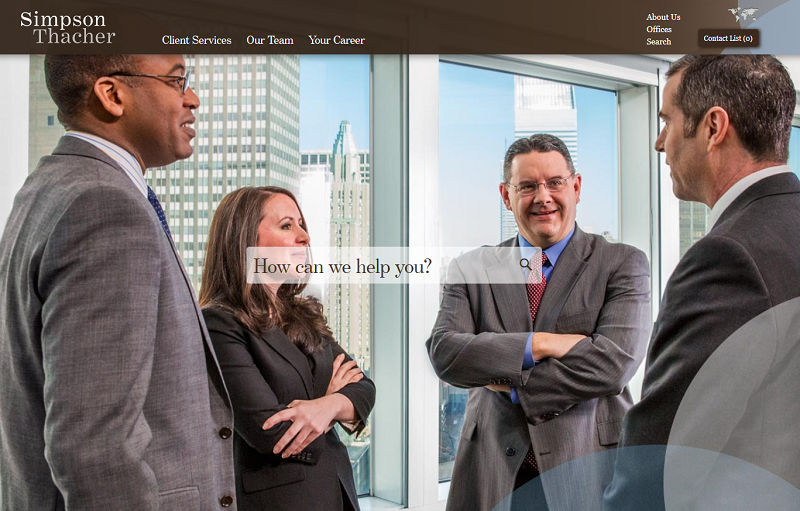
Today, the internet is where people turn to when they need a problem solved, be it fixing a sink, ordering a wedding dress or seeking legal advice. Everyone is online, and they expect every possible service to be online for them as well. If yours is, think of how many new clients your business could attract.
This article is based on the extensive research of the American Lawyer’s 2016 Am Law 100 websites. We have analyzed the digital domains of the 100 most successful U.S. law firms from the viewpoints of design, usability, traffic sources, content management, and search engine optimization.
You will see how an average U.S. legal service website looks like, what your competitors miss out, and which opportunities that brings for your legal business.
RESEARCH METHODOLOGY
Our research was based on an array of criteria: Design, Functionality, Informativeness, Content Marketing, Lead Generation Potential, and Search Engine Optimization (SEO). These criteria were designed by a group of our company’s experts that work in corresponding fields and consist of several components to increase the research objectiveness.
These specialists participated in the evaluation process, along with a group of non-professional respondents, who evaluated the strength of online brand mindprint.
Let us break down our list of criteria, and see what exactly we were looking at on our subject websites.
1.Design
Design is the front gate of every business website, and law firm is no exception. The visual appearance of your digital domain will be the first thing people judge about your business.
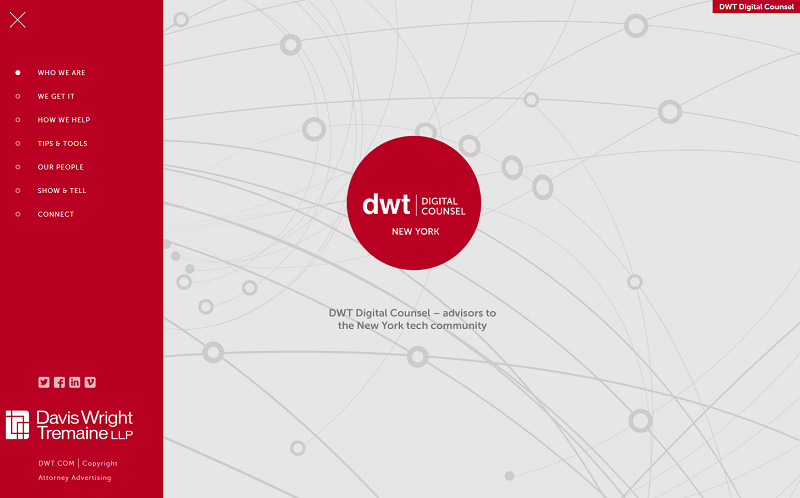
There is a proven psychological pattern called the Halo effect when the first visible trait of an object or person is subconsciously transferred onto all of its other traits.
Several studies revealed that good design is the most important factor of online trust (source: UX Magazine), and can cover for all other aspects of the website, like usability, functionality, informativeness, and content quality, even if they are poor or mediocre (source: Nielsen Group).
Let’s consider a real-world example. If you enter the courtroom in a dirty suit, you will not be treated as a good lawyer, regardless of your actual professional level. Your website is your online suit, by which people form their first impression about your business.
Our design criteria for a good law firm website included the following points:
- Estimated year of launch (whether or not the site is older than 3 years, judged by the evident design trend);
- Animations and interactive elements, which are integral part of user experience these days;
- Responsive mouse-overs and / or smart active corners;
- Trust-driving, professionally looking images, and background renders;
- Smooth screen-scrolling navigation.
In our design evaluations of each of these points, we utilized methods that proved their effectiveness in building lead-generation websites and were polished with the internal use at our company. The complete list of these design evaluation methods can be found here.
2.Functionality
There are certain things that modern internet users expect to be a given on any website. Failing to deliver them may scare your potential clients away.
A good example would be mobile adaptability. The mobile internet traffic in the U.S. has already exceeded desktop traffic (source: Comscore). This is not just a warning bell for companies who failed to adapt to the small screen; this is a whole darn siren. Further in our research, you will see how shockingly few law firms look good on mobile devices, and how many mobile internet users seek a legal advice service online.
In terms of website functionality, here are the things we were after:
- Mobile Adaptability - whether the site is adaptive, or if it has a separate mobile version;
- Widescreen friendly - VIP clients often view sites on extremely large monitors;
- Homepage loading speed. For this purpose, we used a tool called Pagespeed Insights;

These features reflect how friendly your website is to various categories of visitors, and are an important SEO factor (source: Google’s Mobile Friendly Policy).
3.Informativeness
This is the parameter which tells us if the user is able to find what they are looking for on a law firm website. When people make online purchases, the most valuable criterion for them is price. Next, the brand comes, and after that - cost and timeframe of shipping.
For those seeking legal service online, the most important info would be contacts, practices and industries, team and user feedback. These points were confirmed by our legal advisors and several industry experts like Stephen Roussan.
Each case is unique, and the user must have an application form to summarize their problem, often being in a hurry. After that, they have to be able to schedule an appointment. Auxiliary features would be trust drivers and reputation proofs (biographies, firm history, studies of solicited cases, and similar information).

So, below we have come up with our informativeness criteria:
- Locations and contacts
- Practices & industries
- Team & biographies
- Company history
- Case studies
- Client feedback (and its trustworthiness)
Of course, most law firm websites have such features implemented in one way or another. Therefore, we evaluated each one on a scale of 1 to 3, in terms of how quickly a new visitor is able to locate this info, and how comprehensibly it is presented.
4.Content Marketing
Websites have to be kept up to date, or at least create such impression. If the visitor enters a website where the last update was published in 2010, they’ll presume the business is dead.
You have to publish materials regularly to keep your site alive in the visitors’ eyes.
But this is just the basics. It matters that you do post, but what you post matters even more. People who enter your website got to have a good reason to stay there, or they will browse away instantly.
Therefore, you’ve got to make your content:
a) appealing to the visitor, and
b) helpful in solving their problem.
In terms of appeal, there is a clear set of proven practices we’ve composed over the years working with content projects - a good summary of them can be found here. As for making sure your website visitors actually appreciate your content, you must take your time and learn who your visitors are, and what they prefer reading online.
At our company, we use User Persona approach to content marketing, and such practice not only leads to attracting visitors that are more likely to convert into clients but also gets us the kind of clients we want to work with and filter out everyone else.
Considering the above said, here are the content marketing effectiveness criteria, which we used for evaluation of our subject websites:
- Presence or absence of blog. Obviously, this is the indicator of whether or not the site markets its content at all;
- Blog updates over the last 3 months. Again, the business looks alive if the site keeps adding content on a regular basis;
- Average blog posts per month over the last year. This criterion defines whether the firm has a clear focus on content marketing, or just maintains their blog because the trend dictates it;
- Types of posts. The more is usually the better, as it has been strongly advocated by Neil Patel. For example, the blog may only contain case studies, but it would look far more reputable if it also published industry news, video interviews, company updates, new legislation FAQ’s etc. One of the good examples is Haynes & Boone blog - they are doing a really good job publishing actionable posts and materials.
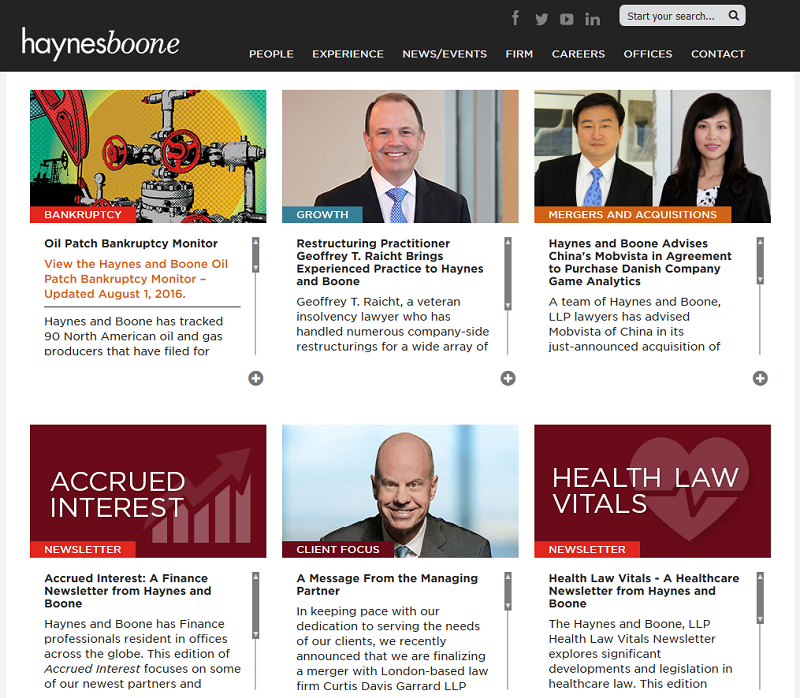
- Availability of practical and educational materials. Most of the visitors come to law firm blogs for expertise. When they browse and find proven solutions for common problems, or the typical cases explained, it would certainly add up to their level of trust to that particular law firm.
5.Lead Generation Potential
Converting your online visitors into business leads is clearly the main reason why you’ve launched and maintained your law firm website. However, it is not a given that every website serves this purpose to a 100%.
When you think of websites as a whole, the first image in your head is probably the website that you have memorized. But what made you memorize it, exactly?
There is something in certain websites that makes us remember them and want to turn to them when we are looking for a solution to a relevant problem. Here is a good piece explaining how this happens. And remembering the site’s image or experience is what likely to turn us into a lead for that website's business.
In our research, we have used the following criteria for lead generability of a law firm website:
- Do visuals of the first screen show that the company is a perfect match for a those who are looking for legal support? Do they show that the company is reputable and able to solve the client’s problems? Studies suggest that we make our visual-based judgments 2000 (!) times faster than we can apprehend the accompanying text (source: eyeQ Insights).
- How clear is the text introduction? The first piece of text that a website visitor is likely to read on a website defines if they are eager to read anything further;
- How strong is the mindprint? In our analysis, we reverted to the list of websites we have explored in 5 minutes and checked whether the respondent has a persistent clear image of the website. If they had, we checked three more criteria below.
- How relevant is the most memorable image (in regard to the first criterion)? Our memory is one big association's game. When the image does not bind well to the message it is meant to represent, such message tends to be forgotten quickly.
- How relevant is the most memorable text (in regard to the second criterion)? Our memory likes to keep catchy phrases, but not the context around them. If a website manages to imprint the right phrase into the visitor’s mind, then the visitor will think of that website when they recall the phrase. A good example can be found on the homepage of Quinn & Emanuel.
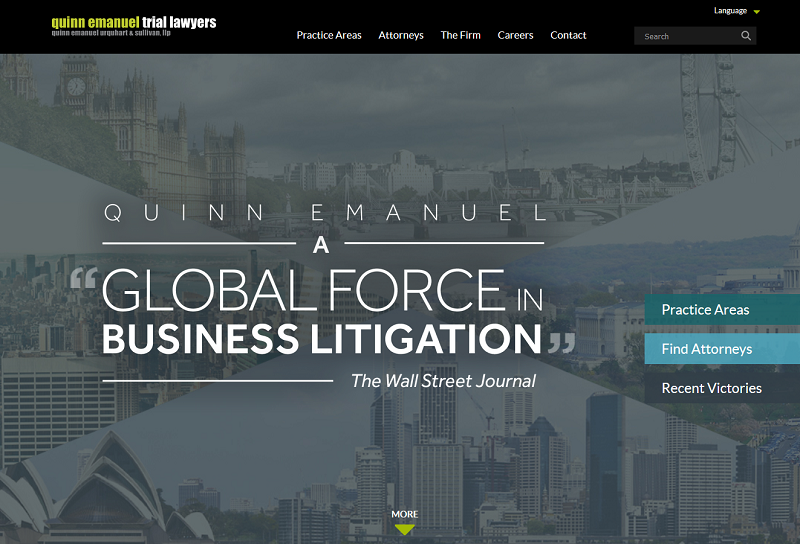
- How memorable are the calls to action? CTA’s are a given for all business websites, but some just work better than the others. We tried to find out which ones do and why.
All of these criteria are totally subjective, but they had to be set in order to define how well the websites cope with their lead generation function. Therefore, as with Informativeness, we evaluated each point in this section on a scale of 1 to 3.
6.Search Engine Optimization
Commonly referred to as SEO, this combination of techniques and activities is treated by some as ‘Google deception’ and a ‘dirty move’. In fact, it really does nothing illegal. SEO is only aimed at delivering your site’s content to the people who are actually interested in it, rather than just having it hang in the void and waiting to be sought out by strangers.
Among other practices, SEO includes the two basics, though most important ones in regard to legal service websites: Keywording and Link building.
Keywording is a practice to enrich your website content with words and phrases that people are likely to enter into their search bars. That way you increase your chances to be displayed in the direct search results.
Link building is another counterpart of SEO. It aims at your web resource being displayed in people’s indirect search results. Search engines, namely, Google, use sophisticated website estimation algorithms, by which the more the website’s content is cited (either linked out or linked to), the more trustworthy it is considered, and the more likely it is to be displayed for a particular search inquiry.
Being applied in synergy, Keywording and Link building are capable of moving your site up in the internet search results. Businesses which neglect these tools are likely to end up at the very bottom of the list.
Based on that, our criteria for search optimization of a law firm website were the following:
- Main page meta title and description. This is the short summary of a website in the user’s search results. If this section is empty, the engine will say that “no description is available”, or simply display the first 160 characters of the website's body text. Either way is not a good way to present a website to the user.
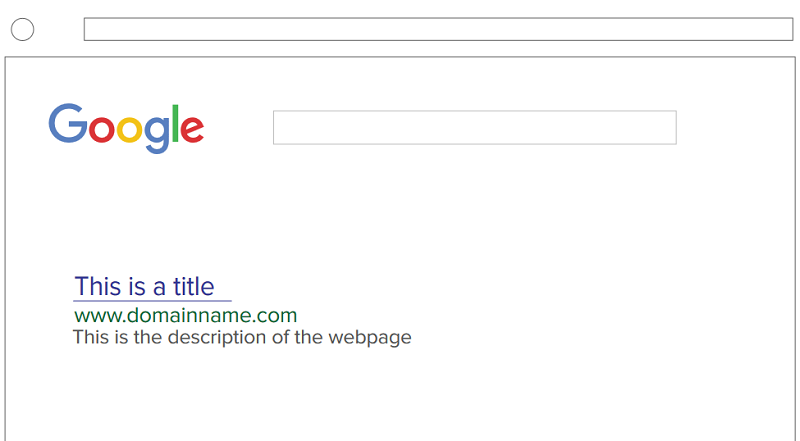
- Auxiliary pages' meta titles and descriptions. Just like with the main page, it’s a good idea to write titles and descriptions for all of your pages.
- Alt tags for images. An alt tag is the textual description of an image, by which the engine searches the internet. Putting a good keyword there ensures that image search will work for your website just as well as the regular textual search. Also, the alt tag will substitute for the image, should it fail to load.
- Industry-associated keywords in the meta titles, descriptions, and alt tags. This should be obvious - if you’ve bothered to invest effort into writing these things, you must make sure they will be working properly.
- Links to trusted and reputable external resources. No matter how reputable your website is by itself, it’s got to cite external resources. When linking out, a good website must lead to the ones that are not worse, at least.
THE OUTCOMES
We have presented the measurements by which we evaluated the 2016 Am Law 100 websites. We believe that such an in-depth and thorough website analysis was never applied to this industry before. That is why we are proud to announce the outcomes, and more importantly, explain what these outcomes mean for your legal business.
1.The Typical Am Law 100 Website
Let us start with the summary of an average website from the 2016 Am Law 100 list. Here, we will sum up the features and traits which we found common for the majority of websites during our analysis. This will help us identify the features and traits they do not possess, and think how implementing them can give your firm’s website the competitive upper hand.
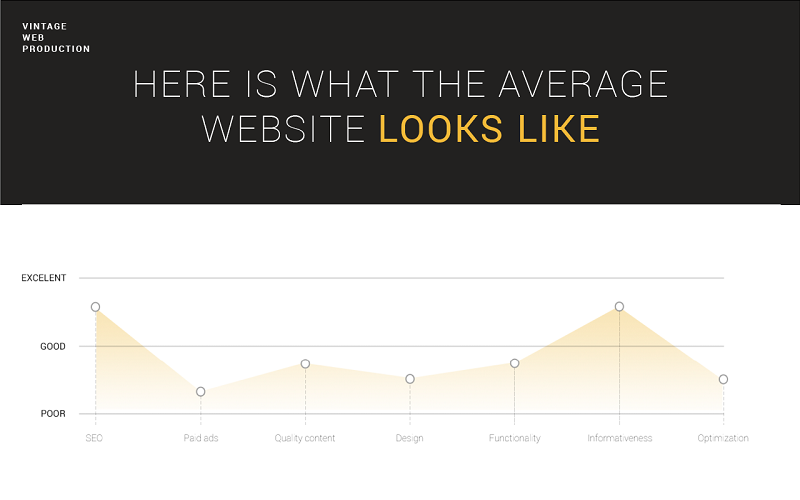
The typical U.S. law firm website turns out to be above mediocre at SEO and Informativeness, but Design, Content, Functionality, Online Advertizing, and Leaf Generation leave much to be desired.
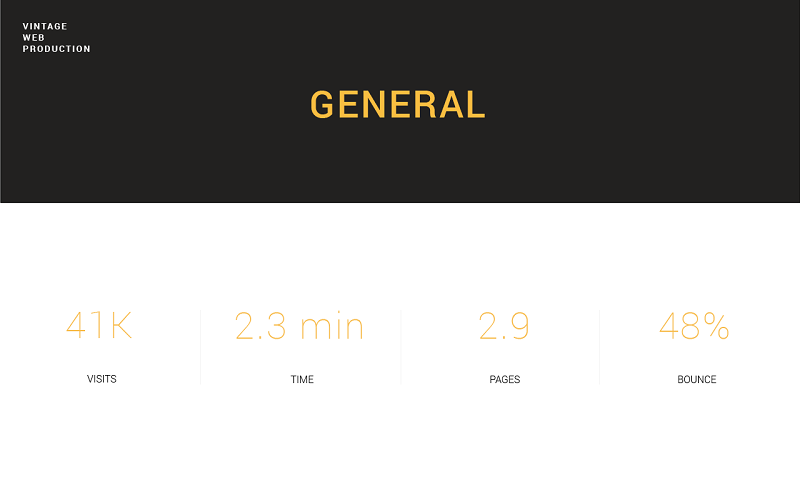
An average Am Law 100 website gets 41,000 visits per month. The average time spent on the website is 2.3 minutes, and the users open roughly 3 pages per visit. The bounce rate (percentage of viewers that close the website after seeing only one page) is 48%.
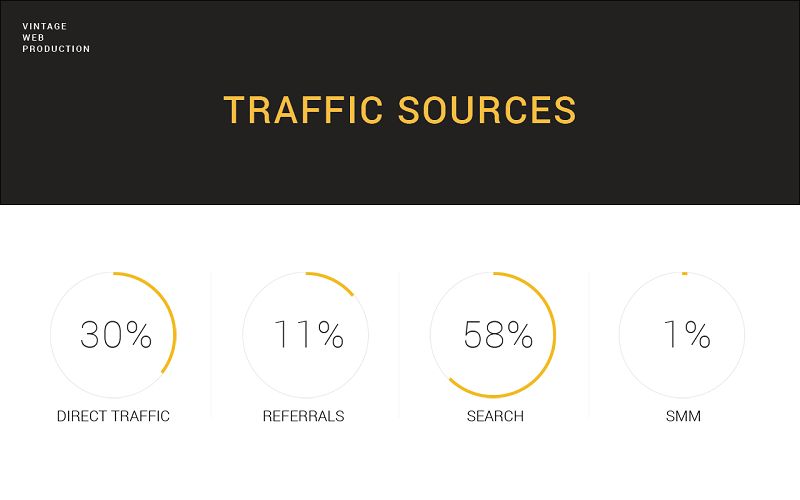
The sources from which the visitors navigate to the average Am Law 100 website are:
- 30% Direct traffic (from simply typing the website address into the browser, or from email campaigns);
- 11% Referrals (by links or ads on external resources);
- 58% Search (from the search results which return on keyword inquiry);
- 1% Social Media (from Facebook, LinkedIn, Twitter and the like).
What does this information tell us?
Firstly, with Search Engine Optimization efforts neglected, 58% of your potential clients will never find your law firm on the Internet.
Secondly, referrals driven by PR efforts and Affiliate Marketing account for only 11% of law firm website visits. Clearly, there is room for improvement for both how law firms post their content and how they market it.
And last but not least. The critically acclaimed role of the social media in the law firm business. Most of the Top-100 U.S. legal companies have established their profiles in popular social networks and have a considerable amount of followers. But as we can see, it doesn’t help them generate traffic.
There are two possible reasons for that:
- they do not publish interesting content (probably because they don’t produce much of it);
- they do not promote the groups to get the right kind of followers.
If you care to invest in the Social media marketing, consider using a tool like Buffer or Google Analytics to track its effectiveness in terms of traffic and lead generation. Chances are it is very ineffective. In this case, you should reduce the quantity of your content, but increase its quality. Post less, but make sure what you post is actually interesting for your followers. Here are a few guidelines on how to create a good SMM content if you work in B2B (source: KissMetrics).
The poor use of SMM here also stands for the advertisement in social media. Obviously, it is not very popular in the legal industry, but that is where your business opportunity lies. Consider investing into paid ads in social media like Facebook, Twitter and try emerging ones like Instagram, which may turn out to be a very cheap lead generation channel for your legal business. Make a small test and see how it works.
Business opportunity:
If you care about Social media, measure your efforts through Google Analytics or Buffer. If they don’t bring you much visitors and clients, consider making changes to your social media strategy, or focusing your energy and enthusiasm on other fields. You might also try to use advertisement in social media and measure the ROI.
2.Design
Our complex web design research revealed that only 13% of the Am Law 100 websites possess the modern and user-friendly features and have been made (or updated) within the last 3 years. The rest of the websites from the list were 4 to 12 years old, and have fallen out of favor long since. We detected HTML5 animations, which are a sign of recent web design, in only 2 websites out of 100.

Business opportunity:
You can easily set yourself apart from the competition by just having an attractively designed website with modern-looking HTML5 animations.
3.Functionality
Keeping in mind that the mobile share of search traffic in the U.S. currently supersedes desktop, we found out that 62% of the Top 100 U.S. legal firms’ websites do not adapt to the mobile screen. And only 7 websites out of 100 have a separate mobile version.
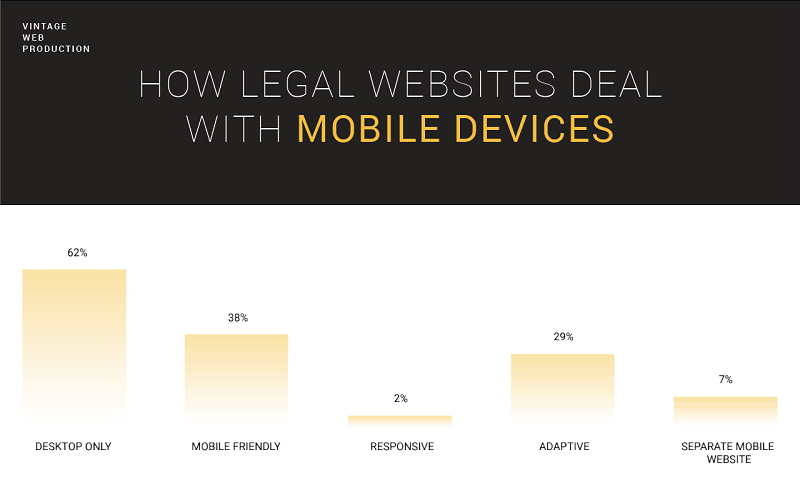
Does your firm’s website look good on the small screen? If it doesn’t, you can clearly see how huge a competitive leverage you are missing out.
As for the website loading speeds, 73% of the subject websites had their landing pages loaded in less than 4 seconds, which can be considered a good result.
Business opportunity:
Making sure your website is at least mobile friendly will filter out 62% of your competitors in mobile search results. Do not miss this opportunity before everyone else starts doing it. Also, you have to make sure that your firm’s website loading time stays within the 4-second timeframe.
4.Informativeness
This is probably the only field where almost all our subject websites excelled at. Every website on the Am Law 100 list has Biographies, Practices, Locations, and Contacts available from the first screen.
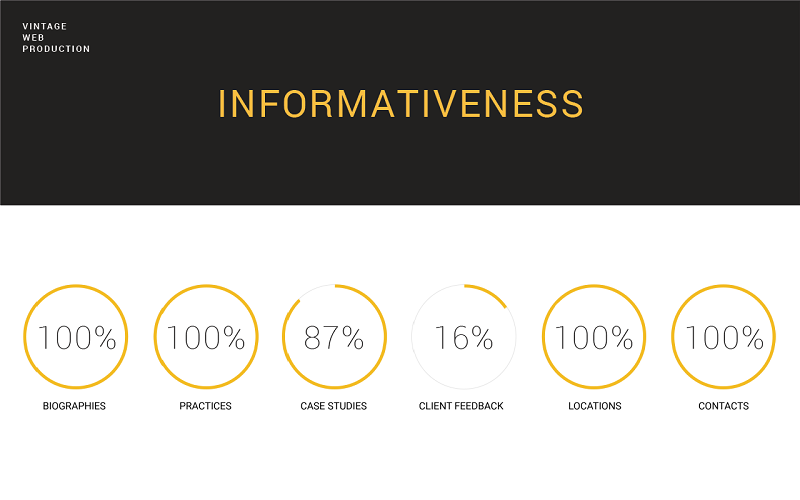
However, lack of Client Feedback turns out to be the common issue. Only 16 of 100 subject websites can actually respond to their client’s online inquiries. When a person seeks legal representation, who are they more likely to hire: the attorney who responded to their online plea, or the one who does not even make that an option?
Business opportunity:
Make it possible to provide client feedback through your website. Simple as that. Respond to your client’s applications, schedule appointments, suggest first approximation solutions to the clients’ problems. Also, as obvious as it may sound, make sure you have your victories published on your website. Surprisingly, some firms still do not bother doing that.
5.Content Marketing
Earlier in this article, we described the power of blogs for your law firm. Imagine our shock when we found out that only 25% of the Am Law 100 websites actually had blogs! The rest only post occasional company and industry news on their main page, and 5 out of 100 never bother to post anything at all.
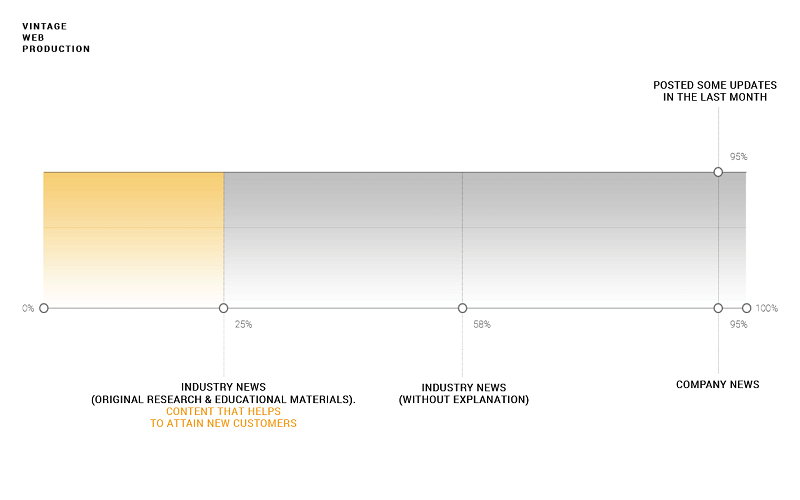
Business opportunity:
We have to underline this once again: blogging about your practice and providing credible pieces of expertise to your site’s visitors is a great business opportunity. 75% of the Top U.S. law firms miss it out. Would you like yours to be in that bunch?
6.Lead Generation Potential
Speaking about measurable figures here, only 27% of the subject websites had clear Calls-to-action on their main page, and less than 7% had a contact form, which is tremendously important for lead generation (source: Main Street ROI).
Furthermore, only 6% had a memorable image that the respondents were able to recall during the next 5 minutes and after watching 10 other websites. With Internal pages and Calls-to-action, the situation was even worse.
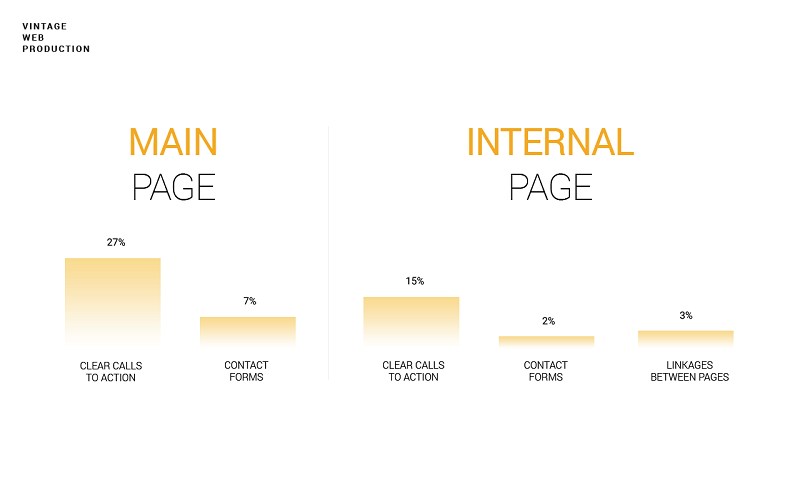
Business opportunity:
It is fair to assume that most of your competitors are poor at online lead generation. You will likely double the number of leads for your law firm by adopting the basic lead generation practices.
7.SEO
As for the link building, 5% of the traffic goes to the companies that do not do link building and 95% - to the ones that do it.
The average number of backlinks on a U.S. law firm website is 14,200, while the number of referring domains is 472. Statistics show that 100 new referring domains are worth nearly as much traffic as 20,000 backlinks from old domains.
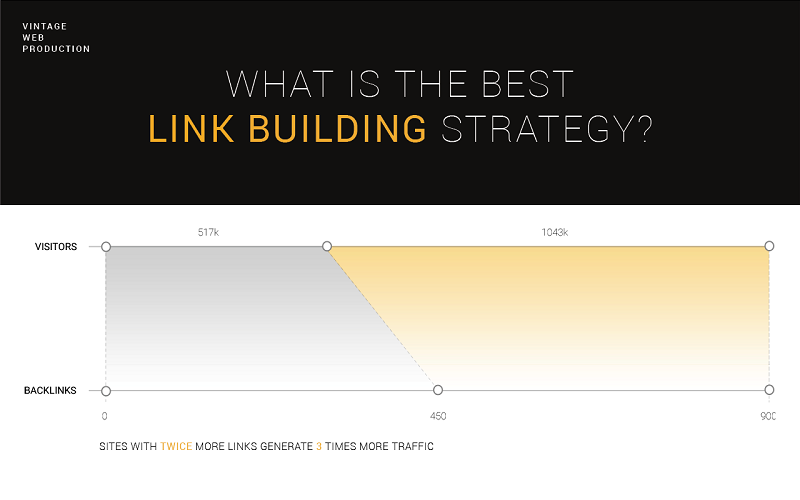
Business opportunity:
Consider focusing on working with new media and partners to get SEO links than working constantly with the same resources. Also, concentrate your efforts on getting links from new domains rather than the old ones.
SUMMARY
The general advice we can give to every U.S. law firm in business would be this: you can get 140-180% more business leads just by improving your website in terms of design, functionality, and lead generation principles. If you consider investing in producing good quality content, and implementing an SEO strategy on a regular basis, it will multiply your website’s incoming traffic ever further (although the changes may not be as quick).
Let us sum up the most important of our findings. For your convenience, we’ve designed this short infographic, which contains the key takeaways of our extensive 100+ hour research.
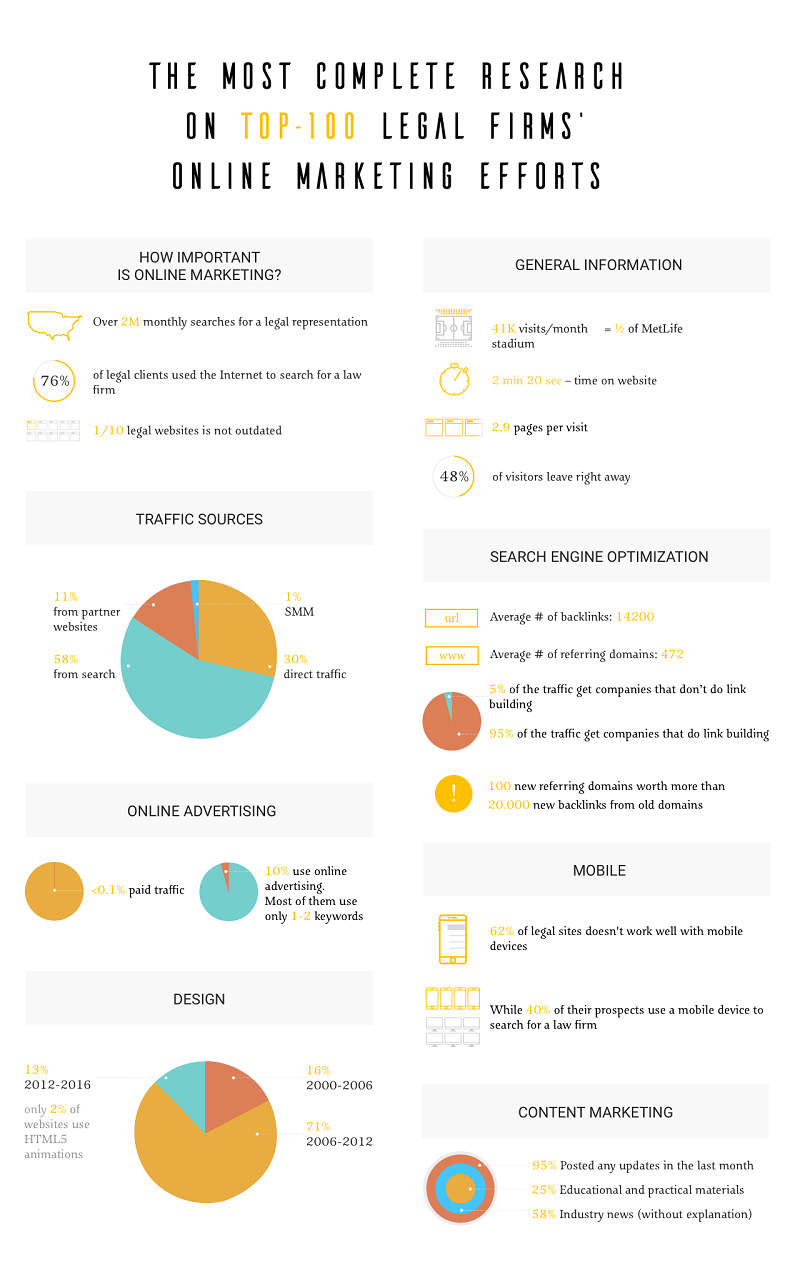
But there’s more! As a bonus, we have prepared an extended, explanatory 50-page presentation for you to summarize the insights on the U.S. Top-100 law firms’ websites, and revise the business opportunities that your law firm can embrace to outcompete your rivals on the online field.
Feel free to share this presentation with your colleagues, and in case you require a more personalized piece of expertise, feel free to contact us here at Vintage - we are always eager to assist.

View Comments